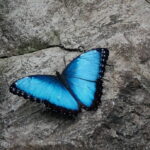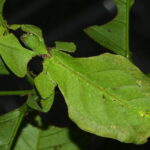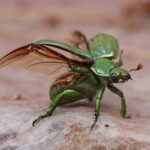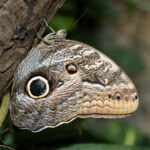Millions of Insects and a Curator at Work

Dyed he is with
the colour of autumn days,
O red dragonfly.
-Bakusui
In October of 2017, ecologist Caspar Hallmann and his colleagues published a paper in PLOS One which revealed evidence of a 75 percent reduction of flying insects in Germany over the past 27 years. 75 percent. This stopped my breath.
I expected the news would hit like an earthquake and shake everyone into an awareness about the importance of insects and the dire future we will face if they disappear. But, like much of the news about environmental devastation, it seemed to go unnoticed. I tried to pacify myself with the thought that perhaps the decline in Germany stood alone. Later in the month, as if to quell my optimism, Jacob Mikanowski published a piece in The Guardian asserting that the German study was not unique. According to his many sources, insect habitats and insects themselves were disappearing at alarming rates all over the globe.
Fluctuations are always happening in ecosystems, but at this point we are beyond what might be considered natural or normal. We should be concerned.
Many of us are familiar with what is being called the Sixth Extinction, but one aspect of this dramatic shift that goes largely unnoticed is the extinctions in the class Insecta. In his piece, Mikanowski reminds readers of the words of renowned entomologist E.O. Wilson, who argued that without insects, humans would only last a few months. Entire ecosystems would quickly collapse. The news of this rapid and impressively large decline of insect populations felt apocalyptic.
On a recent trip to California, I sought out Dr. Peter Oboyski, entomologist and curator of the Essig Museum of Entomology at The University of California, Berkeley, who generously agreed to talk with me. I wanted to learn more about the importance of insects to ecosystems and how studying shifting insect populations over time could help us understand how to slow their decline.

Dr. Peter Oboyski works as the collections manager of the Essig Museum of Entomology at UC Berkeley. Photo by Kathleen Sheffer.
Oboyski fell in love with insects long before he became the curator of Essig, a collection of over 5 million physical specimens, including approximately 35,000 species of insects and spiders, which he is in the process of turning into a digital collection. The Essig Collection is housed in a modest room in the lower corridors of the monumental Valley Life Sciences Building at Berkeley. While the Tyrannosaurus rex skeleton that greets visitors at the entrance is certainly a head-turner, the insects of Essig are equally stunning.
Oboyski first opened a drawer to reveal spindly brown stick insects as long as my hand, and a leaf insect, Phyllium giganteum from the same order Phasmatodea, that was just as long and three-fingers wide. The latter honestly looked to me like a nature project made by a kindergartener—like a bunch of leaves glued together in an symmetrical pattern, an ingenious act of camouflage. Another drawer held rows of radiant blue morpho butterflies, which are frequently featured in Costa Rican tourist brochures, the color of their wings reminiscent of the cerulean blue of the coastal waters of the Caribbean. This effect is made possible by the light reflection on the layers of thousands of tiny scales that make up a butterfly wing. Another drawer held rows and rows of jewel-like beetles, some of them blue-black with enormous horns, others like dime-sized iridescent emeralds. I suddenly understood why the Egyptians immortalized them in the form of scarabs.



Yet another held drawer the elegant owl butterfly, a large velvety brown creature whose ornately patterned wings feature two large black spots, which could easily be misread by a predator as owl eyes, another very clever disguise. Then drawer upon drawer of bees, grasshoppers, damselflies, and dragonflies of many colors and sizes, and so many more. Oboyski has personally collected an impressive number of Indonesian Lepidoptera (moths and butterflies). Each insect is carefully mounted on a pin which punctures its body slightly to the right its center line so one side of its symmetrical body remains fully intact. Beneath each body is a tiny card stating its formal name as well as where and when it was found. The collection is a true treasure trove for insect researchers.



A 4.5-magnitude earthquake shook the Berkeley hills the morning I traveled to Essig, and I immediately thought of the insects in the glass-covered drawers. I was not the only one. When I arrived at the collection, Oboyski and a graduate student stood by the shelves, which contain thousands of insects and labor-intensive entomological data collected over scores of years, discussing earthquake protection. Oboyski plans to make improvements to the drawers so they cannot be shaken easily out of their cases. “Unless the big one hits,” he said. There was no way to really protect the insects from that. But the vulnerability of these physical specimens is only part of why he is interested in digitizing his collection. Many more researchers could have access to this collection once it is digitized to enhance the understanding of insect population changes over time.
Several years ago, Essig became the lead institution on a project called CalBug, a collaboration among curators of eight major terrestrial arthropod collections in California to make one large digital collection—a daunting, if not unfathomable, task. Only 10 percent has been digitized at this point, and it already includes over a million specimens. Part of Oboyski’s interest in this project comes from his desire to understand the relationship of insects to their environment over time. This issue is particularly important now as the earth experiences such rapid and immense change, including mind-boggling numbers of extinctions and habitat loss due to land-use change and climate shifts. Fluctuations are always happening in ecosystems, but at this point we are beyond what might be considered natural or normal. We should be concerned.

The sheer volume of insect species makes collection, cataloging, and sharing of research data a formidable task. CalBug reports that insect collections around the world house more than a billion specimens. Image by Heather Swan, 2017.
Between 1996 and 2000 Oboyski participated, as an entomologist, in a study examining the causes of the steady disappearance of the critically endangered bird called the palila, a golden-headed honeycreeper native to Hawaii. Why would a person who studies insects be called in on a bird project? Because palilas depend on moths for food. Palila parents feed their chicks the caterpillar of a Cydia moth. This particular Cydia moth lays its eggs in māmane trees, and when the caterpillars emerge, the palila eat them. The research team discovered that a non-native wasp, intentionally introduced as an agent for biological control, was also preying on the cydia moths. Additionally, habitat reduction was creating a crisis for the Cydia. As the māmane disappear, the moths also disappear. As the moths disappear, the birds also disappear. Here was a clear example of how a variety of species can be so interconnected. Ecosystems are so fragile, I remarked.

The palila is a critically endangered species of Hawaiian Honeycreeper. They can now be found in only 10 percent of their historical range. Image by Bettina Arrigoni, 2016.
Oboyski was quick to point out to me that “fragile” might not be the best word. Ecosystems are often quite dynamic, he said, fluctuating and changing all the time. Often they can recover from subtle changes, but collapse does happen when there are too many changes. He used one of Paul Erlich’s analogies, which likens a working healthy ecosystem to an airplane. He explained that in Erlich’s analogy, the species in an ecosystem represent rivets in the plane. If you know that one rivet is missing from an airplane wing, you’d probably still get on the flight, but if you learn that a lot of rivets are missing, you recognize that flight is much more likely to fail. Oboyski noted that as landscape changes destroy more and more insect habitats, and urbanization eats up many landscapes, these effects can be devastating to ecosystems. I thought about bulldozers and chainsaws, the felling of trees, endlessly expanding pavement, mountaintop-removal mining, destruction of marshes and fens, housing developments, the warming world, and rampant pesticide use. Where were the creatures to go? And which ones were left?
I asked Dr. Oboyski his thoughts on how best to investigate insect populations through time.
The Essig Collection and other collections like it are a good start in understanding just how many rivets are missing from our ecosystems, but the data can be overwhelming. It is not always gathered geographically. Sometimes specimen cards are hard to read. Sometimes the location might be vague. Sometimes, however, you get a gift, a key to a treasure chest. Oboyski told me that Dr. Joan Ball-Damerow found just such a key when she discovered the work of a naturalist named C.H. Kennedy, who sampled Odonata (dragonflies and damselflies) of California from 1914 to 1915. Ball-Damerow, then a PhD student in entomology at Berkeley, found Kennedy’s work, and revisited 45 specific sites where he had sampled for dragonflies. At those sites, she surveyed the current species richness and habitat, a whole century later. She and her team examined “changes in species occurrence rates, taxonomic richness, and biological trait composition in relation to climate changes and human population increases.” The results described how the dragonfly populations had changed over time as habitat changed or vanished. Some species, the “generalists,” were more successful at survival than the “specialists.” As the name implies, specialists require a unique set of food sources and environmental parameters. Urbanization and water use or shortages definitely take their toll, but there is also evidence of resilience and flexibility.

Maintaining water quality in urban settings is crucial for insect health. Image by Heather Swan, 2017.
A couple of years ago, my son, Eli, assisted on a dragonfly survey coordinated by Bradley Herrick from the University of Wisconsin–Madison Arboretum. The project gathered data about dragonfly populations and habitats from approximately fifty ponds in urban and rural wetlands in southern Wisconsin. Included in the project were drainage ponds near industrial areas, ponds in the UW Arboretum, which were surrounded by restored prairie, as well as large natural spring-fed ponds. I accompanied him on a few occasions, climbing through brush higher than my head or leaping over rock barriers and fences to reach our destinations. As Eli sampled water turbidity and took note of wind speed and temperature, I stood quietly and observed the phenomenon of dragonfly flight.
In a feat of absolutely brilliant engineering, a dragonfly can hover, fly backwards, make incredibly swift changes in direction, and can reach speeds of 35 miles an hour as it beats its four wings approximately thirty times a second. These adult insects are predators and feed on mosquitoes and other smaller insects, and their larvae eat mosquito larvae as well. One dragonfly can eat anywhere from 30 to 100 mosquitoes a day. Dragonflies also provide food for fish and frogs, among others. Eli taught me that the large blue-green dragonflies were called Common Green Darners, though to me they seemed far from common. The elegant brown-bodied ones with white markings on their wings were aptly named White Spotted, and we even saw a smaller flashy red dragonfly called a Scarlet Skimmer.
I admit I was shocked that all of these varied wetlands seemed to have quite healthy dragonfly populations. Of course, I had no idea which species were missing, but I saw how urban wetlands could potentially provide habitat for species which were experiencing reduction of their natural habitats. There are many variables, including, very essentially, water quality. The results of Herrick’s study will undoubtedly help our communities think about how to take care of those spaces in order to provide a place for at least the generalist species, which can be more flexible about their living arrangements. Small shifts in our thinking about conservation and management of urban wetlands could be one way to prevent the disappearance of these insects.
Before I left Essig, I asked Oboyski about his dreams for his future work. In addition to digitizing his collection for researchers, he is very interested in outreach to larger communities. He and his team already have events like their “Butterfly Workshop,” when the collection is opened up to the public and experts give talks about life cycles, host plants, behaviors, and identification. Oboyski also wants to create an app which would help people identify insects, or simply see them, as they were hiking or walking down the street. He wants everyone to discover the amazing and important world of insects and the things they need to survive. Perhaps with this increased awareness, we can begin to change our human impact on the earth and shift the tide of destruction. We could keep our green spaces filled with native flowers for butterflies and the many kinds of bees. We could commit to keeping water clean and free of pesticides for dragonflies and frogs and ourselves. We could slow the invisible extinction of these tiny but crucial creatures.
Featured image: A red dragonfly rests on a flower. Image by Paul VanDerWerf, 2014.
Heather Swan is a lecturer in the Department of English and the Nelson Institute of Environmental Studies at the University of Wisconsin–Madison. Her book, Where Honeybees Thrive: Stories from the Field is now available from The Pennsylvania State University Press. Twitter. Contact.

The general public has no concept of the severity of ecosystem disturbance and collapse. Scientists simply must find a way to alert and educate the public about these issues! How can we educate the public about the very serious dangers of pesticide use? — Organic Homesteader N. MS.
Thank you for your comment, Michele. I also worry about ecosystem health. I think there are many people working to raise awareness through their work. Scientists like Peter Oboyski are doing outreach projects. Lots of writers and artists are sharing their perspectives and knowledge. Lots of individuals are simply having conversations with neighbors. I just finished teaching a group of innovative interdisciplinary students who are interested in thinking of new ways for humans to exist without so much negative environmental impact. I think there is hope!